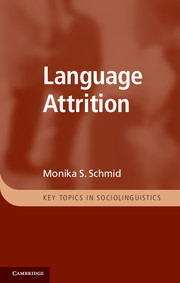Book contents
- Frontmatter
- Contents
- List of figures
- List of tables
- Preface
- Abbreviations
- 1 Introduction
- Part I Linguistic aspects of language attrition
- Part II Extralinguistic aspects of language attrition
- Part III Conducting research on language attrition – preliminary considerations
- 9 The test populations: participant characteristics and acquisition
- 10 Types of linguistic knowledge
- Part IV Experimental designs for attrition research – the language attrition test battery
- Part V Coding and analysing the data
- 18 Conclusion
- Glossary
- Notes
- References
- Index
9 - The test populations: participant characteristics and acquisition
Published online by Cambridge University Press: 05 June 2012
- Frontmatter
- Contents
- List of figures
- List of tables
- Preface
- Abbreviations
- 1 Introduction
- Part I Linguistic aspects of language attrition
- Part II Extralinguistic aspects of language attrition
- Part III Conducting research on language attrition – preliminary considerations
- 9 The test populations: participant characteristics and acquisition
- 10 Types of linguistic knowledge
- Part IV Experimental designs for attrition research – the language attrition test battery
- Part V Coding and analysing the data
- 18 Conclusion
- Glossary
- Notes
- References
- Index
Summary
To test attrition, you need attriters, and you usually also need ‘controls’, speakers who are similar to the attriters in terms of age, gender etc. but still live in the country where their L1 is spoken. How do you set about finding groups of such speakers? What do you need to keep in mind when you select them? This chapter will acquaint you with some of these considerations.
The first question you have to ask is what your experimental population is going to look like. Try to formulate as clearly as possible the subject characteristics that you are looking for. As you saw in Part II, a daunting number of external factors can impact on the process of language attrition, and these may often interact in unexpected or unpredictable ways. Such characteristics of the participants in an experiment, which may influence the outcome variables but which the researcher cannot or does not attempt to manipulate (for example, we cannot make a subject older or younger than she is, nor can we change how often she has spoken her first language or how long ago she emigrated), are called independent variables or predictors.
Be thorough
The fact that attrition is conditioned by so many predictors confronts the researcher with the dilemma of which factors to include in the research design, and which to exclude through controlling them. It is impossible to investigate everything. How many factors you can investigate depends largely on the size of your sample.
Tip
When you plan your investigation, a good rule of thumb is that you should have at least fifteen subjects for each of the external criteria which you want to investigate.[…]
- Type
- Chapter
- Information
- Language Attrition , pp. 109 - 124Publisher: Cambridge University PressPrint publication year: 2011



